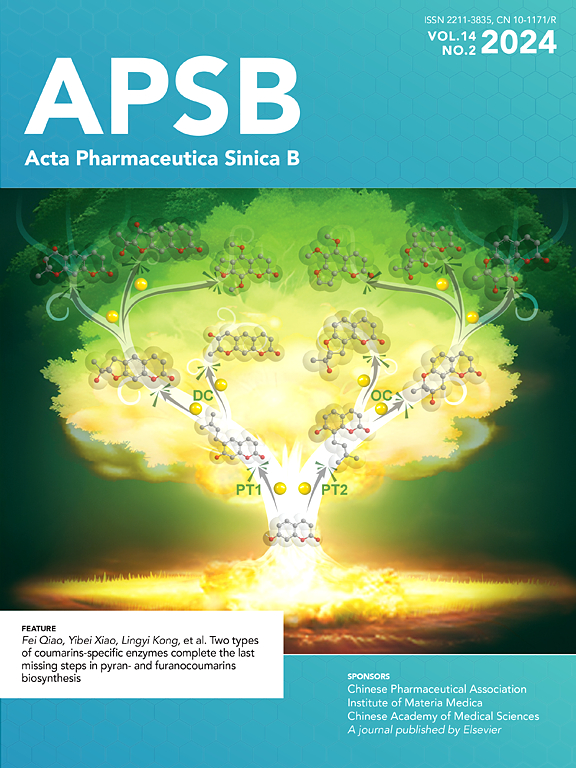纳米工程线粒体可通过替代功能障碍线粒体治疗眼部线粒体疾病
IF 14.7
1区 医学
Q1 PHARMACOLOGY & PHARMACY
引用次数: 0
摘要
勒伯遗传性视神经病变(LHON)是一种眼部线粒体疾病,涉及线粒体复合体 I 的损伤,是导致全球青壮年失明的重要原因。然而,由于欧洲批准的治疗 LHON 的药物依地苯酮依赖于绕过复合体 I 缺陷而非修复该缺陷,因此该疾病尚无可用的治疗方法。在此,研究人员设计了mRNA负载纳米粒子(mNP)工程线粒体(mNP-Mito),通过输送外源线粒体来替代功能失调的线粒体,使复合体I的功能正常化,从而治疗LHON。mNP-Mito 有助于补充健康线粒体(其中含有功能性 I 型复合体线粒体转移),同时消除功能障碍线粒体(其中 I 型复合体功能受损),增强 PARKIN 介导的有丝分裂过程。在使用复合物 I 抑制剂(鱼藤酮,Rot)诱导的小鼠模型中,mNP-Mito 增强了健康线粒体的存在,与受到 Rot 损伤的组别(29.5%)相比,mNP-Mito 显示出复合物 I 活性的急剧增加(76.5%),这极大地促进了 ATP 生成的恢复和眼线粒体疾病相关表型的缓解。这项研究强调了纳米工程线粒体的重要意义,它是线粒体疾病疗法中替代功能障碍线粒体和修复线粒体功能的一种前景广阔的可行工具。本文章由计算机程序翻译,如有差异,请以英文原文为准。

Nanoengineered mitochondria enable ocular mitochondrial disease therapy via the replacement of dysfunctional mitochondria
Leber's hereditary optic neuropathy (LHON) is an ocular mitochondrial disease that involves the impairment of mitochondrial complex I, which is an important contributor to blindness among young adults across the globe. However, the disorder has no available cures, since the approved drug idebenone for LHON in Europe relies on bypassing complex I defects rather than fixing them. Herein, PARKIN mRNA-loaded nanoparticle (mNP)-engineered mitochondria (mNP-Mito) were designed to replace dysfunctional mitochondria with the delivery of exogenous mitochondria, normalizing the function of complex I for treating LHON. The mNP-Mito facilitated the supplementation of healthy mitochondria containing functional complex I via mitochondrial transfer, along with the elimination of dysfunctional mitochondria with impaired complex I via an enhanced PARKIN-mediated mitophagy process. In a mouse model induced with a complex I inhibitor (rotenone, Rot), mNP-Mito enhanced the presence of healthy mitochondria and exhibited a sharp increase in complex I activity (76.5%) compared to the group exposed to Rot damage (29.5%), which greatly promoted the restoration of ATP generation and mitigation of ocular mitochondrial disease-related phenotypes. This study highlights the significance of nanoengineered mitochondria as a promising and feasible tool for the replacement of dysfunctional mitochondria and the repair of mitochondrial function in mitochondrial disease therapies.
求助全文
通过发布文献求助,成功后即可免费获取论文全文。
去求助
来源期刊

Acta Pharmaceutica Sinica. B
Pharmacology, Toxicology and Pharmaceutics-General Pharmacology, Toxicology and Pharmaceutics
CiteScore
22.40
自引率
5.50%
发文量
1051
审稿时长
19 weeks
期刊介绍:
The Journal of the Institute of Materia Medica, Chinese Academy of Medical Sciences, and the Chinese Pharmaceutical Association oversees the peer review process for Acta Pharmaceutica Sinica. B (APSB).
Published monthly in English, APSB is dedicated to disseminating significant original research articles, rapid communications, and high-quality reviews that highlight recent advances across various pharmaceutical sciences domains. These encompass pharmacology, pharmaceutics, medicinal chemistry, natural products, pharmacognosy, pharmaceutical analysis, and pharmacokinetics.
A part of the Acta Pharmaceutica Sinica series, established in 1953 and indexed in prominent databases like Chemical Abstracts, Index Medicus, SciFinder Scholar, Biological Abstracts, International Pharmaceutical Abstracts, Cambridge Scientific Abstracts, and Current Bibliography on Science and Technology, APSB is sponsored by the Institute of Materia Medica, Chinese Academy of Medical Sciences, and the Chinese Pharmaceutical Association. Its production and hosting are facilitated by Elsevier B.V. This collaborative effort ensures APSB's commitment to delivering valuable contributions to the pharmaceutical sciences community.
 求助内容:
求助内容: 应助结果提醒方式:
应助结果提醒方式:


